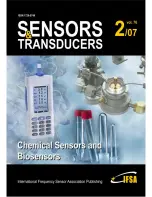
Sensors & Transducers Journal, Vol.76, Issue 2, February 2007, pp.935-936
the clinical analysis to be performed at the bedside, in the critical care units and doctor’s clinic rather
than in the centralized laboratories.
2. Biosensors in Health Care and Diagnostics
With rising healthcare costs and to improve patient care, diagnostic laboratories have been challenged
to develop new tests that are reliable, cost–effective and accurate and to optimize existing protocols by
making them faster and more economical. Although there are number of commercial successes, but
most successful to date is the glucose biosensor [17] for routine monitoring of glucose in blood by
individuals suffering from diabetes. The basic principle is that glucose is recognized by the bioreceptor
layer i.e. the glucose oxidase enzyme to yield the redox active species like hydrogen peroxide (H
2
O
2
)
and gluconic acid. Out of these H
2
O
2
passes through a series of membranes and is finally detected at
the working electrode. The resulting electrical current is amplified and recorded. Other compounds,
which may give an artificial signal or foul the electrode, are excluded by the membrane system.
Companies are fabricating implantable biosensors that can trace blood glucose levels and
simultaneously deliver insulin. For example “Microchips” is testing a chip implant that offers long
term, time-controlled drug delivery [18]. Compatibility with microfabrication and ability to store and
release drugs on demand would have potential applications in medical diagnostics, industrial process
monitoring and control, combinatorial chemistry, microbiology, and fragrance delivery[19]. More
importantly, it may provide new treatment options to clinicians in their fight against disease. The next
step is to develop a manually, wirelessly controlled biosensor that detects and treats an acute condition,
and then a biosensor that will approximate an artificial organ. This will permit sensing a condition and
responding automatically without user intervention.
Biosensors also offer enormous potential in detecting wide range of analytes that are regularly needed
to show a patient’s metabolic state especially for those who are hospitalized, more so if they are in
intensive care. Critical care is one of the most challenging (and stressful) areas of medicine, in the
sense that the decision makers (primarily doctors, nurses and ambulance staff) must take their
decisions quickly. At the moment of first examination, the patient’s clinical state is usually unknown,
and once known, it is prone to rapid change. The earlier these fundamental clinical data are provided; a
reasoned therapeutic decision can be taken instantly for enhancing success rate. Biosensors that
facilitate the measurement of calcium[20], lithium[21], lactate[22], cholesterol[23], urea[24], uric
acid[25], oxalate[26], triglycerides[27], ascorbic acid[28] and creatinine[29] have been demonstrated
and needs refinement for commercial viability. External biosensors are used in emergency rooms as
point-of-care diagnostic units – such as I-Stat’s “lab on a chip”, which can reveal almost immediately
whether a patient is under cardiac arrest by testing blood chemistry[30]. Similarly, it will be extremely
helpful to have instantaneous on-site determinations for creatinine, sodium, potassium, chloride, and
CO
2
levels of patients in the dialysis unit of a hospital or at a hemodialysis center.
Several variants of the classical biosensors are already thriving in the medical field. A new biosensor
technology based on magneto-resistive sensors is introduced by Philips [31]. This biosensor measures
the magnetic field created by magnetic nano-particles that bind to target molecules in a biological
assay. Compared with optical sensing methods, the use of magnetic nano-particles eliminates the
additional steps required to bind optical labels to the target molecules and improves sensitivity.
Oak Ridge National laboratory (ORNL) has developed “
Medical Telesensor
” chip (Fig-2) which can
measure and transmit data related to body temperature [32]. Similar chips are being developed as a
defense need for military personals to transmit data essential data to the remote monitor. This monitor
alerts the medical team in critical circumstances.
939














